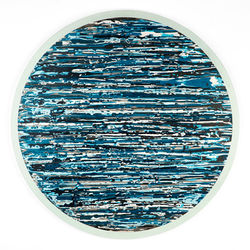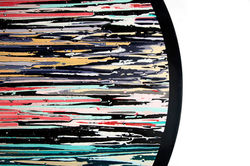
VESSELS
VESSELS
VESSELS
VESSELS
VESSELS
VESSELS
TABLES
VESSELS
VESSELS
VESSELS
VESSELS
VESSELS
VESSELS


STRATA
A SYNTHETIC STUDY

The extensive process of creating the work merely bares witness to how nature reveals its Strata. This project aims to explore many of the processes that bend, fracture or erode our landscapes. These geological processes, which often take millions of years to form, will be adapted and distorted as the study develops. By engineering manufacturing processes that embody an element of chaos and randomness in the layering of stratified deposits, the work aims to reveal a stratigraphy of alluring aesthetic in an instant.The work has been divided into sub categories according to the nature of the Strata formation.
In geology and related fields, a stratum (plural: strata) is a layer of sedimentary rock or soil with contrasting characteristics that can easily be distinguished from the other surrounding layers. The study aims to reflect the constant perpetual movement of the subterranean world, but is juxtaposed with colour pallets that reflect the man-made nature of today’s world. This clear distinction of sedimentary layers has become the focus of this study, for by artificially amplifying these distinctions we re-appropriate a natural phenomenon. In effect, resulting in geological revelations in key with a segment taken from a parallel world.
.
Strata are revealed through the natural accumulation of sediments such as chemical or biological sedimentation or natural events such as ash falls, lava flows, landslides or even asteroid impacts. This study however, wishes to manufacture and control the geological processes that produce stratified deposits using designed systems and inorganic materials for the sole purpose of slicing through layers to reveal a visual composition unknown to the current laws of nature, yet still reflective of them.
FOLDS
Folds in geological terms are formed from stress or pressure applied to sedimentary rock. These folds are produced by the slumping of the layers at their weak points and are a phenomenon that occurs on a huge variety of scale and multitude. To mimic such a process, thin sheets of metal are compressed on a horizontal axis. This produces an organically folded and creased landscape which forms the origin of the visual language of the work. This landscape is then deposited in thin layers of synthetic strata, that once built to a considerable thickness can then be sliced into thin sections.
 |  |
|---|---|
 |  |
 |  |
 |  |
 |  |
 |
FOLDS TABLE - 94cm x 178cm x 8cm - acrylic composite, fibreglass, polyester
FOLDS WALL PIECE - 65cm x 155cm x 4cm - acrylic composite, mdf, bees wax
EROSION
These complex and irregular concentric formations are produced by chemically eroding a flat bed of synthetic land. The surface of this once flat land organically dissolves into a cavernous and undulating deposit. Weathered by the elements this surface becomes smooth, and as the layers of sediment are built up, the original surface becomes no longer recognisable. The catalytic event is forgotten and hidden beneath the surface, until finally revealed as a thin slice capturing all the moments in time into one map, a map that reflects movement, erosion and time.
 |  |
|---|---|
 |  |
 |  |
 |  |
 |  |
 |  |
 |  |
 |  |
 |  |
 |
EROSIION TABLE - 94cm x 178cm x 8cm - acrylic composite, fibreglass, polyester
EROSION TABLE (round) - 105cm x 105cm x 7cm - acrylic composite, fibreglass, polyester
FOLDS WALL PIECE - 65cm x 170cm x 4cm - acrylic composite, mdf, bees wax
IGNEOUS
Individual igneous strata are formed by an array of free flowing rivers of soft plastic that each eventually solidify. The process is repeated in hundreds of layers allowing the material to flow freely around itself, mimicking the colliding flows of molten lava, each taking the path of least resistance. Slicing though the end result reveals the unpredictable contrast of positive and negative space, resulting in formations that mystify the origins of this thin section.
 |  |
|---|---|
 |  |
 |  |
 |  |
 |  |
 |  |
 |
IGNEOUS WALL PIECES - 104cm x 104cm x 4cm - acrylic composite, mdf, bees wax
STALAGMIAS
These works are inspired by the same type of rock deposition found in stalagmites. Over thousands of years, ceiling drippings often from limestone caves form an accumulation of deposited material that over time grows vertically. By repetitively dripping different coloured synthetic deposits from the same point, a distinctively layered mound is created, allowing each drip to form over the last. Once the diameter of the work is achieved, the mound is sliced into a thin section to reveal the staggered yet concentric patterns of a synthesised stalagmite-like formation.
 |  |
|---|---|
 |  |
 |  |
 |  |
 |  |
STALAGMIAS (round) - 115 cm x 115cm x 4cm - acrylic composite, mdf, bees wax
STALAGMIAS - 35cm x 120cm x 3cm - acrylic composite, mdf, bees wax